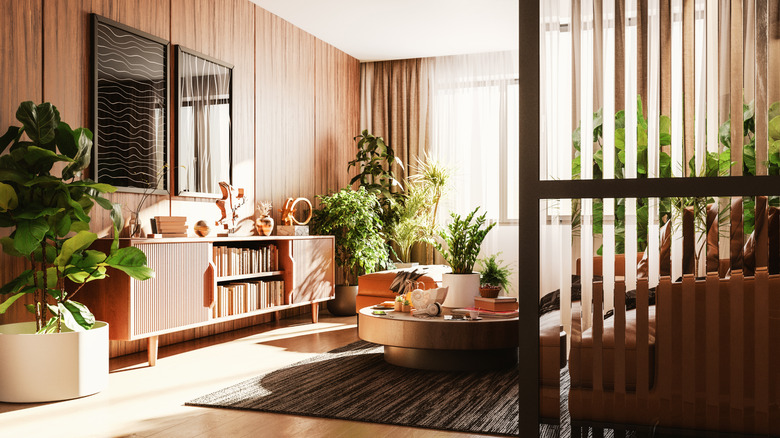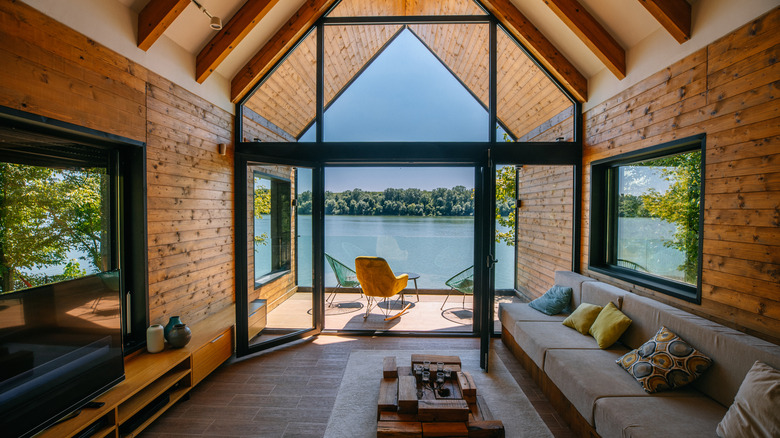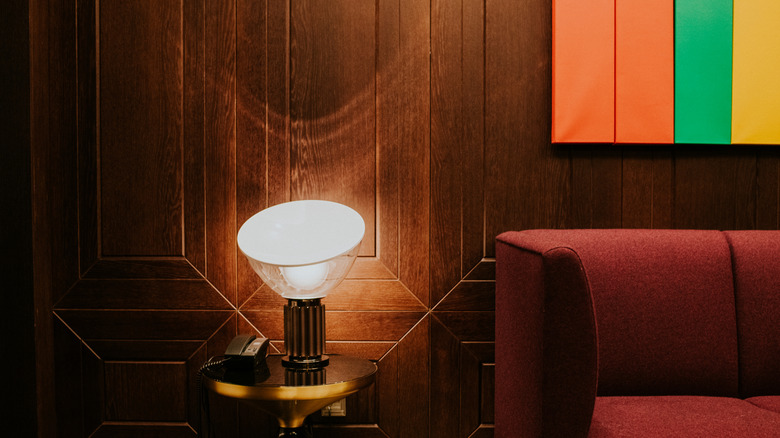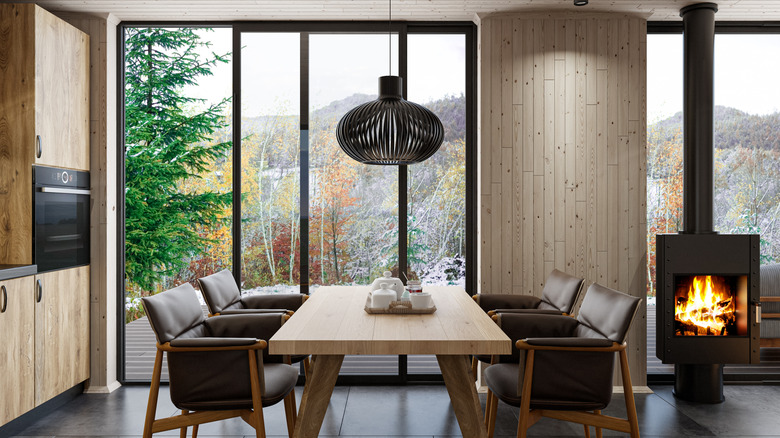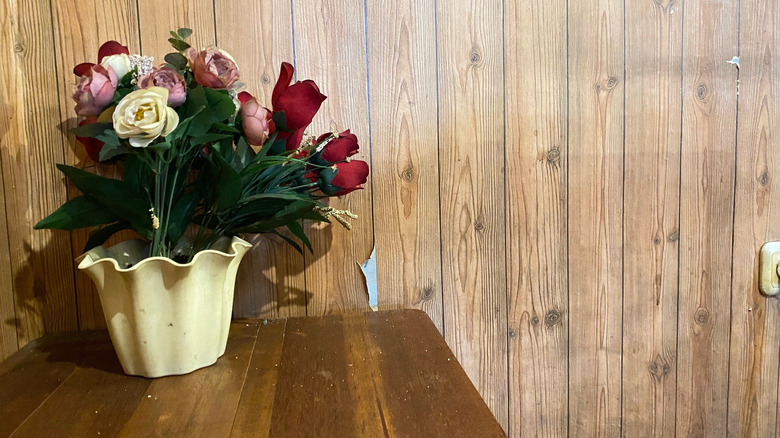Design Mistakes You Need To Avoid Before Hopping Into The Wood Drenching Trend
Material drenching has long been in vogue, from fully marble bathrooms to stone-covered dining rooms. But the latest wood-drenching trend, which features walls and ceilings covered with natural wood grain paneling, transforms your space into a secluded cabin-like sanctuary. The 70s-inspired wood-soaked aesthetic adds character to a space. It can feel cozy and elegant at the same time, creating depth as it roots you in nature and into a sense of calm. Think, wood-panelled ceilings and walls with matching wood trim and moulding, or an accent wall that serves as a beautiful focal point. Certain styling choices can significantly impact the overall look of your room; some can enhance its charm, while others you should definitely avoid.
It's a far cry from the neutral and sleek details of many minimalistic and contemporary styles, but this design trend can provide warmth and sophistication to a space. Drenching your room with airy oak or rich walnut can add a striking twist to different interior styles, like a free-spirited bohemian living room or a modern rustic bedroom. However, you stand the risk of overwhelming a room or making it look tacky, so it's always best to weigh the pros and cons to be sure this wood-drenching trend is a good fit for you. If you conclude that it is, then ensure to avoid the following design mistakes.
Not considering your home's architecture
In the same way that you would consider your interior style when introducing a new design element to your home, you should think about your home's architecture before drenching a room with wood details. Aside from complementing the architectural style of your home, wood-drenching can emphasize certain parts of your home, so it's worth considering how adding wood will enhance or take the spotlight away from specific details and fixtures. For example, if you have vaulted ceilings, wood drenching can feel naturally integrated into the home's architecture because it increases the perceived spaciousness of the space. Adding wood cladding to elaborate moulding or trim, or enveloping a small room entirely, are also great ways to make the wood-drenching trend work with your home's architecture.
Generally, styles like midcentury modern, contemporary, and Scandinavian can complement this trendy cabin-like design choice. But even with these styles, before you decide to drench, it's still necessary to confirm it corresponds with your home's architectural design aesthetically.
Underestimating your lighting
In interior design, lighting is an important part of tying a space together. Not only does it set the mood, but it can also affect the impact and aesthetic of your room, how it feels, the perceived size and spaciousness of the room, and how it corresponds to the rest of your architectural features. In the case of wood drenching, it's important to choose wood that fits both artificial and natural lighting, and to also consider how your selected illumination choices will cause light to bounce off your wood finish.
Artificial light from yellow bulbs (the ones with softer hues) provides warm undertones that complement rich walnut or cherry wood and can work well in classic interior styles. Cool, white LED lighting, on the other hand, pairs naturally with lighter, more contemporary woods like ash or birch. Consider natural light, as well, and how your wood choice absorbs the light and affects the color.
Ignoring color and undertones
It's a known fact that color does a lot to set the vibe and energy of a space. The same goes for material drenching. Whether you choose a dark or light finish depends on how you want to present the space; light wood finishes can bring warmth and brightness to a room, while enveloping a room with a dark color can make it feel moody yet sophisticated.
You'll want to consider the wood's undertone, too. Neutral undertones can feel effortlessly timeless and adapt to different architectural designs. Wood finishes with warm undertones, like cherry or mahogany, can feel relaxed and luxurious, whereas cool undertones, such as birch and ash wood, can prompt feelings of relaxation and calmness. It's also worth noting the other wood elements that you may have in the space and ensuring that they complement each other. Undertones can make a space look put together when you're mixing wood, and having too many can increase the risk of clashing.
Improperly mixing wood
Mixing wood can be a tasteful way to add even more depth to a wood-soaked space. But like many styling choices, it can also make or break a room, too. First, you want to identify your dominant wood, which is likely the one you use to drench the space. You don't necessarily need to match your wood floors or furniture with the same type of wood as your wall panelling or cladding, but they should share the same undertones. Mixing undertones, or having too many wood shades in general, lacks cohesion and can easily overwhelm the space.
Plus, certain woods work better with some than others, so it's worth noting compatible wood pairings. For example, neutral woods, like beige or taupe, are a good base to use since they can complement warm or cool-toned woods. Layering light and dark wood can add depth to the space through contrast. What's more, this balance breaks up the monotony of wood-drenched rooms, so it feels more cozy and inviting.
Using non-natural wood
While faux wood works well to add a rustic touch to beams and accent walls, using natural material to drench an entire room is probably your best bet at making the space feel natural and sophisticated, per the experts. Aside from potentially making the space look cheap, choosing faux wood laminate or veneer doesn't have the same unique grain patterns or color variations as real wood does. Not only does it lack variety, but faux wood can instantly date your home.
For these reasons, you want to avoid non-natural wood; otherwise, it can look and feel tacky and wouldn't give the space the warmth or charm that natural wood would. For a clean and elegant touch, you may opt for natural walnut or oak cladding. Recycled or reclaimed wood, while more pricey than new wood, can give the space a natural, distressed look that complements the signature lived-in look of rustic and farmhouse styles.
